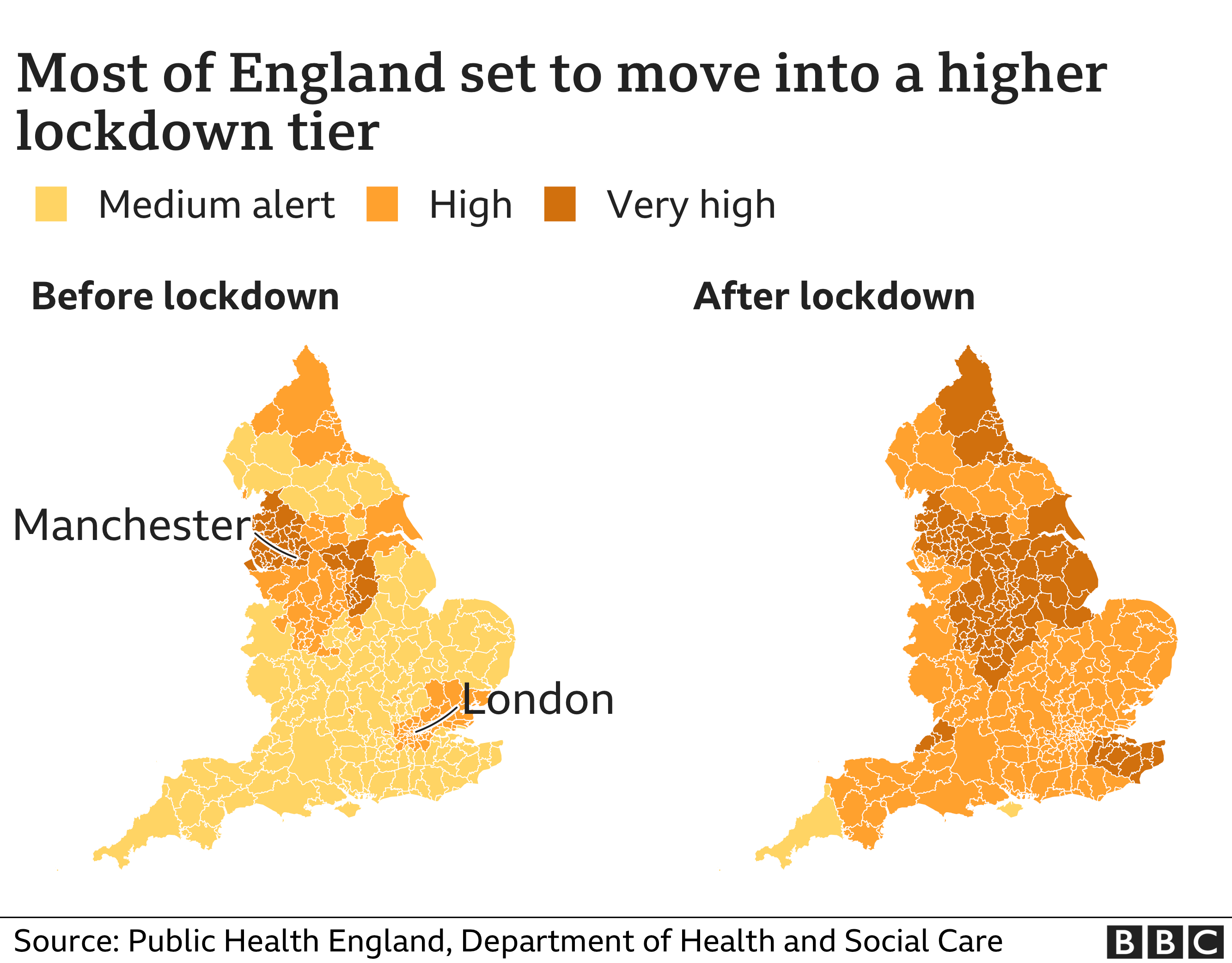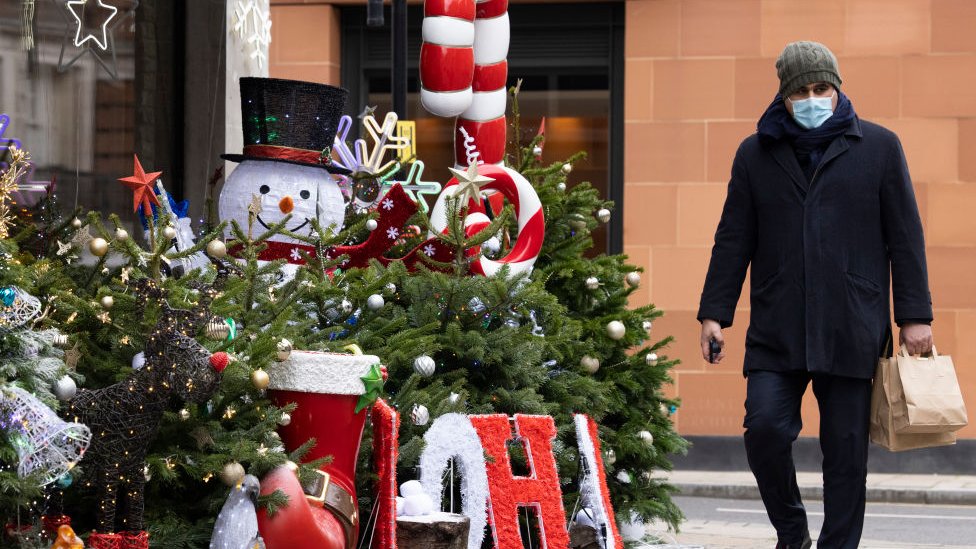Most of England will be in the two toughest levels of measures when the national lockdown ends next week.
The new coronavirus tier restrictions will mean 55 million people remain banned from mixing with other households indoors after 2 December.
Large parts of the Midlands, North East and North West, including Manchester, as well as Kent, are in tier three.
A majority of places are in the second highest level - tier two - including London, and Liverpool city region.
The Isle of Wight, Cornwall and the Isles of Scilly - where there have been no recorded cases in the past week - will be the only areas of England in the lowest level of curbs - tier one.
Meanwhile, a rush for details saw the government website repeatedly crash.
Health Secretary Matt Hancock set out the reasoning behind the tier decisions for each area in a written ministerial statement.
Mr Hancock told the Commons: "Hope is on the horizon but we still have further to go. So we must all dig deep."
"We should see these restrictions not as a boundary to push but as a limit on what the public health advice says we can safely do in any area," he added.
Around 23 million people across 21 local authority areas will be in the highest level - tier three - including Birmingham, Leeds, Sheffield, Tees Valley Combined Authority and North East Combined Authority.
Lancashire, Leicester, Lincolnshire, Slough, Bristol, Kent and Medway will also be in tier three.


Differences between the new tiers include restrictions on where households can meet up:
- tier one: the rule of six applies everywhere, indoors and out
- tier two: the rule of six applies outdoors but there is no household mixing anywhere indoors
- tier three: can only meet other households in outdoor public spaces like parks, where the rule of six applies
Gyms and close-contact beauty services like hairdressers will be able to open in all tiers. Guidance said people in all tiers who can work from home, should continue to do so.
Pubs and restaurants in tier two can only open to serve "substantial meals", while those in tier three can only operate as a takeaway or delivery service.
Hospitality bosses said nearly nine in 10 venues believed they "are not viable to operate" within tiers two and three.

Starting off high

Make no mistake, this is only a gradual step out of lockdown.
At the start of November more than half the country was in tier one, meaning households could mix indoors in people's homes and in pubs and restaurants as long as they kept to the rule of six.
Now that is only possible in Cornwall, the Isle of Wight and Isles of Scilly.
Infection rates are showing early signs of coming down, but the government is erring on the side of caution.
Research suggests they were too slow to put areas in higher tiers before lockdown.
They do not want to make that mistake again - and so are starting off high in the hope they can move areas down the tiers.
But it is not only about which area is in which tier.
The top two tiers have been beefed up, particularly in regards to hospitality.
One ray of hope, the government says, is the experience of Liverpool.
Before lockdown it was in tier three and seeing among the highest infection rates in the country.
Today it has now been put in tier two with infection levels pretty close to the national average.

BBC analysis showed 32.2 million people live in tier two areas, 23.3 million in tier three and just 713,573 in tier one.
The system will be regularly reviewed and an area's tier level may change before Christmas - the first review is scheduled for 16 December.
Prime Minister Boris Johnson will lead a Downing Street news conference at 17:00 GMT.
The new tier restrictions will be voted on by MPs, with the government already facing opposition from its own backbenchers.
Leading Conservative MP Sir Graham Brady told BBC Radio 4's World at One he would vote against the measures, saying: "I do think that the policies have been far too authoritarian."

- MASS TESTING: Where is it available?
- FACE MASKS: When do I need to wear one?
- SCHOOLS: What will happen if children catch coronavirus?
- TESTING: How do I get a virus test?

Decisions on tiers are based on public health recommendations informed by a series of public health data, including Covid-19 cases among the over-60s, positivity rates, pressure on the NHS and how quickly cases are rising or falling.
Areas placed in tier three will be eligible for rapid or "lateral flow" tests - which give results in about 20 minutes without the need for a lab - to help bring down infections and reduce restrictions.
And they will be offered support by NHS Test and Trace and the armed forces to deliver a six-week rapid community testing programme.
Devolved administrations in Scotland, Wales and Northern Ireland have the power to set their own coronavirus regulations, though all four UK nations have agreed a joint plan for Christmas.

In tier three Lancashire, chair of the council's resilience forum, Angie Ridgwell, said there was "disappointment" but also clarity over what needed to happen to lower infection rates.
Mayor of Liverpool Joe Anderson said the city region's move from tier three to tier two was a "great result" and thanked residents for their efforts to drive down the virus alongside a trial of mass testing.
"We embraced tier three restrictions and worked fast to deliver the testing pilot, bringing in the Army to help us deliver an efficient service," he said.
Mr Hancock said Covid-19 cases in Liverpool had fallen 69% in six weeks and the city showed that "the more people get tested, the quicker an area can move down through the tiers".
Mayor of London Sadiq Khan said the decision to place the capital in the second-highest level - tier two - was the result of people's "monumental sacrifice" and would be a "welcome boost" for businesses.
It came as data from the Office for National Statistics showed coronavirus infection rates in England were continuing to show signs of levelling off.

- BRAND NEW DRAMA 'WE ARE WHO WE ARE': A show about first love and the messy, confusing exhilaration of being a teenager. From the director of Call Me By Your Name.
- HOW TO VACCINATE THE WORLD: Who should be at the front of the queue for a vaccine? Those with the greatest need or the highest bidder?


How have you been affected by coronavirus? What have lockdown restrictions meant for you? Share your experiences by emailing haveyoursay@bbc.co.uk.
Please include a contact number if you are willing to speak to a BBC journalist. You can also get in touch in the following ways:
- WhatsApp: +44 7756 165803
- Tweet: @BBC_HaveYourSay
- Please read our terms & conditions and privacy policy
If you are reading this page and can't see the form you will need to visit the mobile version of the BBC website to submit your question or comment or you can email us at HaveYourSay@bbc.co.uk. Please include your name, age and location with any submission.
https://news.google.com/__i/rss/rd/articles/CBMiJmh0dHBzOi8vd3d3LmJiYy5jby51ay9uZXdzL3VrLTU1MDg2NjIx0gEqaHR0cHM6Ly93d3cuYmJjLmNvLnVrL25ld3MvYW1wL3VrLTU1MDg2NjIx?oc=5
2020-11-26 13:43:00Z
CBMiJmh0dHBzOi8vd3d3LmJiYy5jby51ay9uZXdzL3VrLTU1MDg2NjIx0gEqaHR0cHM6Ly93d3cuYmJjLmNvLnVrL25ld3MvYW1wL3VrLTU1MDg2NjIx
Tidak ada komentar:
Posting Komentar